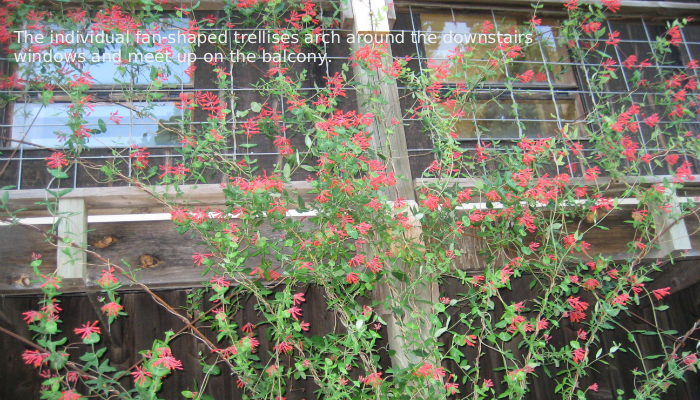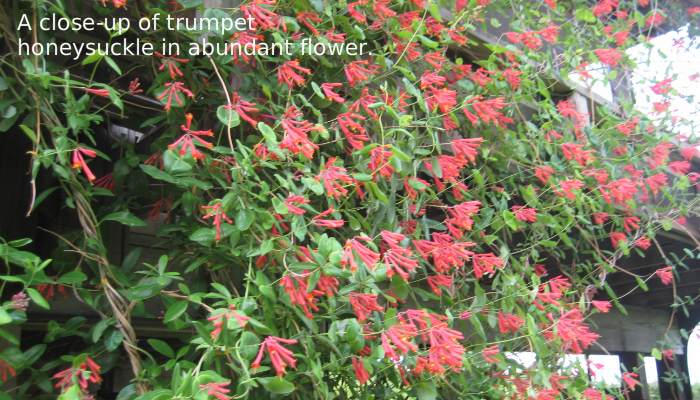Native Honeysuckle Trellis Also Caters to Orioles

Earlier this year I posted a blog regarding a trellis system that I had built across the south side of our house, made from slender steel rods, and planted with native trumpet honeysuckle. Later this year, by mid-May, the vines were covered with flowers and had again attracted hummers. But the surprise was that it also attracted a pair of Baltimore orioles.
The orioles didn’t hover, but stayed close together, perched on the wires of the trellis and the balcony railing, harvesting flowers within reach. The male, when seen from the window four feet away, was resplendent in his flaming orange breast and underwings, which he managed to flash at the female every few minutes, no doubt reinforcing his message that he was a studly fellow with a great territory. The female seemed sorta dull colored compared to others I had seen, but checking my field guides, Sibley says the females are “exceedingly variable,” while Crossley says “highly variable,” so nothing unusual here.

Their beaks were too short and too wide to reach deep into the slender floral tubes for nectar, but they bypassed the flowers pollination agenda by biting off and eating the base of the flower. Some birds are known to eat flowers to get carotene to enhance their feather color. Baltimore orioles are well-known to come to sugar-water feeders, grape jelly, and sweet fruits, so their appetite for nectar is not surprising. But permit me to toss to you my speculation about them eating a piece of the red floral tube, which was readily documented by the residue of shortened stubs littering the floor of the balcony.
The western version of the same species is Bullock’s oriole, which looks much like Baltimores, wearing yellow and black instead of orange and black. When Baltimores migrate south to Florida and Cuba for the winter, flowers in bloom are a rare find along the way, nor are blooms abundant in the first months at their winter quarters, so their orange fades toward yellow and they start looking more like Bullock’s orioles.
When viewed at different angles, the Baltimore’s orange breast does not change color, so this is feather pigment color, not a structural color. Perhaps, by blending red flower pigment into basic yellow feather pigment, our local orioles are able to maintain the color orange, much like you and I could do with red and yellow paint. In May, here, there are few other native red flowers in bloom, so trumpet honeysuckle may play a useful role in Baltimore orioles breeding cycle, and is another good reason to grow it.
I still hope to capture a close-up photo of the pair in action, with flowers flying. But as I write this on Memorial Day, their flashy courtship season will soon settle down into domestic responsibilities and they will have their own assignments, so maintaining color may become less important, although they might still come for the nectar.


